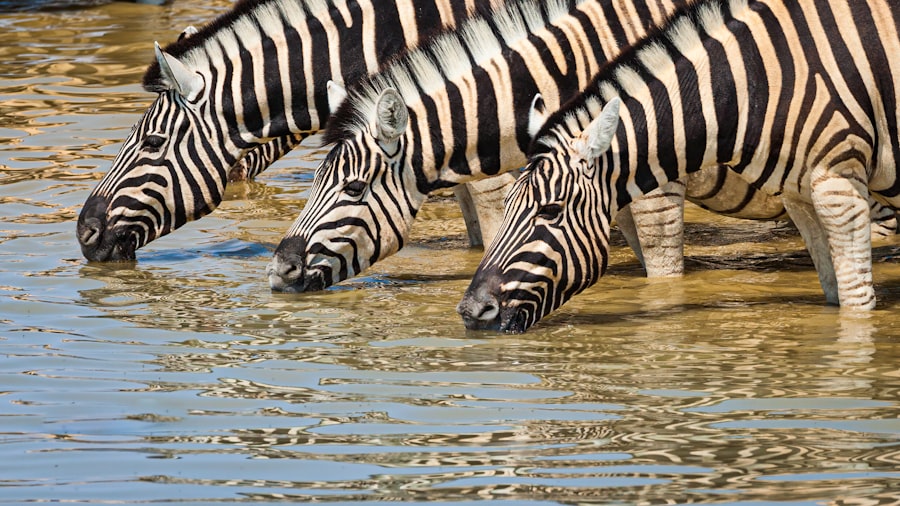Etosha National Park Namibia, located in northern Namibia, is a vast expanse of wilderness that offers an unparalleled experience for photographers. Spanning over 22,000 square kilometers, the park is characterized by its unique salt pans, savannahs, and diverse ecosystems. The landscape is not only visually stunning but also teeming with wildlife, making it an ideal location for capturing breathtaking images.
Photographers from around the globe flock to Etosha to document its rich biodiversity, which includes elephants, lions, giraffes, and a myriad of bird species. The park’s accessibility and well-maintained roads further enhance its appeal, allowing photographers to navigate easily and find the perfect vantage points. The best time to visit Etosha for photography is during the dry season, which typically runs from May to October.
During this period, animals congregate around waterholes, providing excellent opportunities for close-up shots. The stark contrast between the arid landscape and the vibrant wildlife creates a dramatic backdrop that is perfect for capturing the essence of African wildlife. Additionally, the golden hour—just after sunrise and before sunset—offers soft lighting that enhances the colors and textures of both the animals and their surroundings.
This magical time of day is when photographers can truly bring their images to life.
Key Takeaways
- Etosha National Park Namibia offers incredible photographic opportunities for wildlife enthusiasts
- The park’s diverse wildlife and stunning landscapes make it a dream destination for photographers
- Photographers can capture the beauty of Etosha through its unique landscapes, diverse wildlife, and stunning sunsets
- Etosha National Park is a haven for wildlife photography, with opportunities to capture iconic African animals in their natural habitat
- National Park photography tips can help photographers make the most of their experience in Etosha, from capturing wildlife to stunning landscapes
Capturing the Wildlife: Etosha National Park’s Photographic Opportunities
Etosha National Park Namibia is renowned for its diverse wildlife, which presents countless photographic opportunities. The park is home to various species, including the endangered black rhino, large herds of elephants, and prides of lions. Each animal offers a unique chance to capture their behaviour and interactions within its natural habitat.
For instance, observing elephants as they play in the mud or lions as they rest in the shade can lead to stunning action shots that tell a story. Photographers can also take advantage of the park’s numerous waterholes, where animals frequently gather, providing a dynamic setting for wildlife photography. Birdwatchers will find Etosha equally rewarding, as the park boasts over 340 bird species.
From the strikingly colourful lilac-breasted roller to the majestic African fish eagle, each bird presents an opportunity for captivating imagery. The seasonal migrations also attract various species, making it possible to capture unique moments throughout the year.
Photographers can experiment with different techniques, such as using long lenses for close-ups or wide-angle shots to capture the vastness of the landscape filled with wildlife.
The combination of diverse species and stunning scenery makes Etosha a treasure trove for wildlife photographers.
The Beauty of Etosha: A Photographer’s Guide to the National Park
The beauty of Etosha National Park lies not only in its wildlife but also in its striking landscapes. The park features various terrains, including grasslands, woodlands, and the iconic Etosha Pan—a massive salt flat that glimmers under the sun. This unique geological feature provides a stark contrast to the surrounding vegetation and creates an otherworldly atmosphere that is perfect for photography.
The expansive views from various lookout points allow photographers to capture sweeping panoramas that showcase the park’s natural beauty. In addition to its landscapes, Etosha is also home to stunning sunsets, which can transform the sky into a canvas of vibrant colours. Photographers can take advantage of these moments by positioning themselves at strategic locations to capture the interplay of light and shadow across the terrain.
The changing weather patterns can also add drama to photographs; storm clouds rolling in can create a moody atmosphere that enhances the visual impact of an image. By understanding the diverse beauty of Etosha, photographers can create a portfolio that reflects both the wildlife and the breathtaking landscapes of this remarkable national park. For more information, visit Etosha National Park.
Exploring Etosha: A Photographer’s Dream Destination
| Category | Metrics |
|---|---|
| Number of Wildlife Species | 114 |
| Size of Etosha National Park | 22,270 square kilometers |
| Waterholes | Over 30 |
| Photography Opportunities | Abundant |
| Accommodation Options | Various lodges and campsites |
Exploring Etosha National Park is an adventure that combines wildlife observation with photographic opportunities at every turn. The park’s network of roads allows visitors to traverse different habitats, each offering unique chances to capture stunning images. From open plains where herds of zebras graze to dense bush where elusive leopards may be hiding, every corner of Etosha holds potential for remarkable photography.
Guided tours are available for those who prefer expert insights into animal behaviour and optimal shooting locations. Moreover, self-drive safaris are popular among photographers who wish to set their pace and explore at leisure. This flexibility allows photographers to linger at waterholes or return to favourite spots during different times of day with varied lighting conditions.
The thrill of spotting wildlife in their natural environment adds an exhilarating dimension to the photographic experience. With patience and keen observation skills, photographers can capture candid moments that reveal the complex connections between animals and their surroundings.
Etosha National Park: A Haven for Wildlife Photography

Etosha National Park stands out as a haven for wildlife photography due to its rich biodiversity and unique ecosystems. The park’s dedication to conservation has allowed populations of various species to thrive, providing photographers with ample opportunities to document their behaviours and interactions. The presence of large mammals such as elephants and rhinos is particularly significant; these animals are often seen in dramatic poses against the backdrop of the park’s stunning landscapes.
The infrastructure of the park also facilitates the pursuit of wildlife photography. Well-placed viewing platforms and strategically located waterholes enhance visibility and accessibility for photographers seeking the perfect shot. Additionally, numerous lodges within and around the park provide specialised photography tours, guided by experienced guides who comprehend animal behaviour and optimal shooting techniques.
This combination of natural beauty and supportive infrastructure makes Etosha an exceptional destination for both amateur and professional photographers alike.
The Magic of Etosha: National Park Photography Tips
To make the most of a photography trip to Etosha National Park, several tips can enhance the experience and improve image quality. First and foremost, investing in a good camera with a versatile lens is essential; a zoom lens allows for capturing distant wildlife without disturbing them. Additionally, using a tripod can stabilise shots during low-light conditions or when photographing landscapes.
Timing is crucial in wildlife photography; early mornings and late afternoons provide the best light for capturing animals in action while avoiding harsh midday sun. Patience is equally important; waiting quietly at waterholes or known animal paths can yield incredible opportunities for candid shots. Lastly, understanding animal behaviour can significantly improve your chances of capturing unique moments—knowing when animals are likely to be active or how they interact with one another can lead to compelling photographs that tell a story.
Etosha Game Drive:
A game drive is a guided safari experience where visitors are taken on a tour of a wildlife reserve or national park in a specially designed vehicle. The purpose of the game drive is to observe and photograph wild animals in their natural habitat. A knowledgeable guide will lead the drive, providing information about the animals, behaviour and the surrounding ecosystem. Game drives are a popular activity for tourists seeking an up-close encounter with Africa’s iconic wildlife, including lions, elephants, giraffes, and rhinos. The experience offers a thrilling opportunity to witness these majestic creatures in the wild and learn about conservation efforts to protect their habitats.
Etosha National Park: A Photographer’s Paradise
For photographers seeking an unforgettable experience, Etosha National Park is truly a paradise. Its diverse ecosystems provide an eclectic mix of subjects ranging from majestic elephants to vibrant birdlife against stunning backdrops. The park’s unique features, such as the expansive salt pans and varied landscapes, offer endless creative possibilities for capturing striking images.
Moreover, the sense of adventure that comes with exploring this vast wilderness adds an exhilarating element to photography trips. Each day spent in Etosha presents new opportunities for discovery—whether it’s witnessing a rare animal sighting or capturing a breathtaking sunset over the pan. This combination of natural beauty, abundant wildlife, and thrilling exploration makes Etosha National Park an essential destination for any photographer looking to expand their portfolio while immersing themselves in one of Africa’s most remarkable landscapes.
Discovering Etosha: National Park Photography Adventures
Embarking on photography adventures in Etosha National Park allows individuals to connect deeply with nature while honing their skills behind the lens. Each expedition offers unique experiences that can lead to unforgettable photographs—whether it’s tracking down elusive predators or capturing intimate moments between mothers and their young. The excitement of exploration stimulates creativity and motivates photographers to challenge their limits.
Participating in workshops or guided tours can further enhance these adventures by offering informative perspectives on composition, lighting techniques, and animal behaviour. Engaging with fellow photographers creates a sense of belonging, while sharing tips and experiences enriches the overall journey.
Ultimately, discovering Etosha through photography not only results in stunning images but also creates lasting memories that resonate long after leaving this extraordinary national park.
FAQs
What is Etosha National Park?
Etosha National Park is a wildlife reserve located in Namibia, known for its diverse wildlife and unique landscapes. It is home to a wide variety of animal species, including elephants, lions, giraffes, and rhinos.
What makes Etosha National Park a great destination for photographers?
Etosha National Park offers photographers the opportunity to capture stunning wildlife and landscapes in their natural habitat. The park’s diverse wildlife and unique scenery provide endless photographic opportunities.
What are some photography tips for capturing wildlife in Etosha National Park?
Photographers visiting Etosha National Park should use a telephoto lens to capture wildlife from a safe distance. It’s also important to be patient and observant, as wildlife sightings can be unpredictable. Additionally, early morning and late afternoon are the best times for photography due to the soft, golden light.
What are the best locations within Etosha National Park for photography?
Some of the best locations for photography in Etosha National Park include waterholes, where wildlife congregates, and the vast open plains, which provide stunning backdrops for wildlife photography. The park’s iconic salt pans also offer unique photographic opportunities.
What wildlife can be found in Etosha National Park?
Etosha National Park is home to a wide variety of wildlife, including elephants, lions, leopards, giraffes, zebras, rhinos, and numerous bird species. The park’s waterholes attract a diverse range of animals, making it a prime location for wildlife photography.
What is the best time of year to visit Etosha National Park for photography?
The dry season, from May to October, is considered the best time to visit Etosha National Park for photography. During this time, wildlife congregates around waterholes, making it easier to spot and photograph a variety of species.


